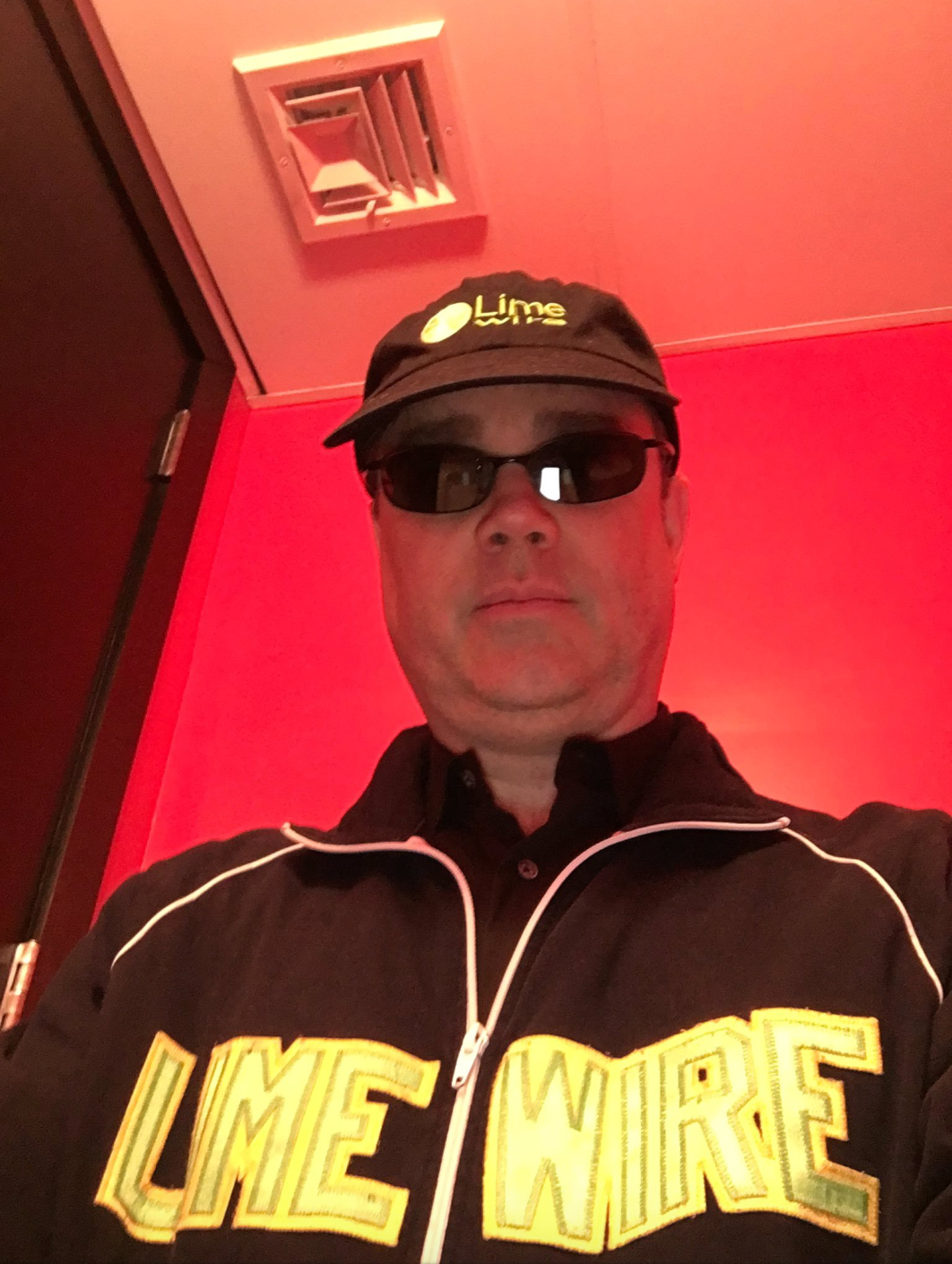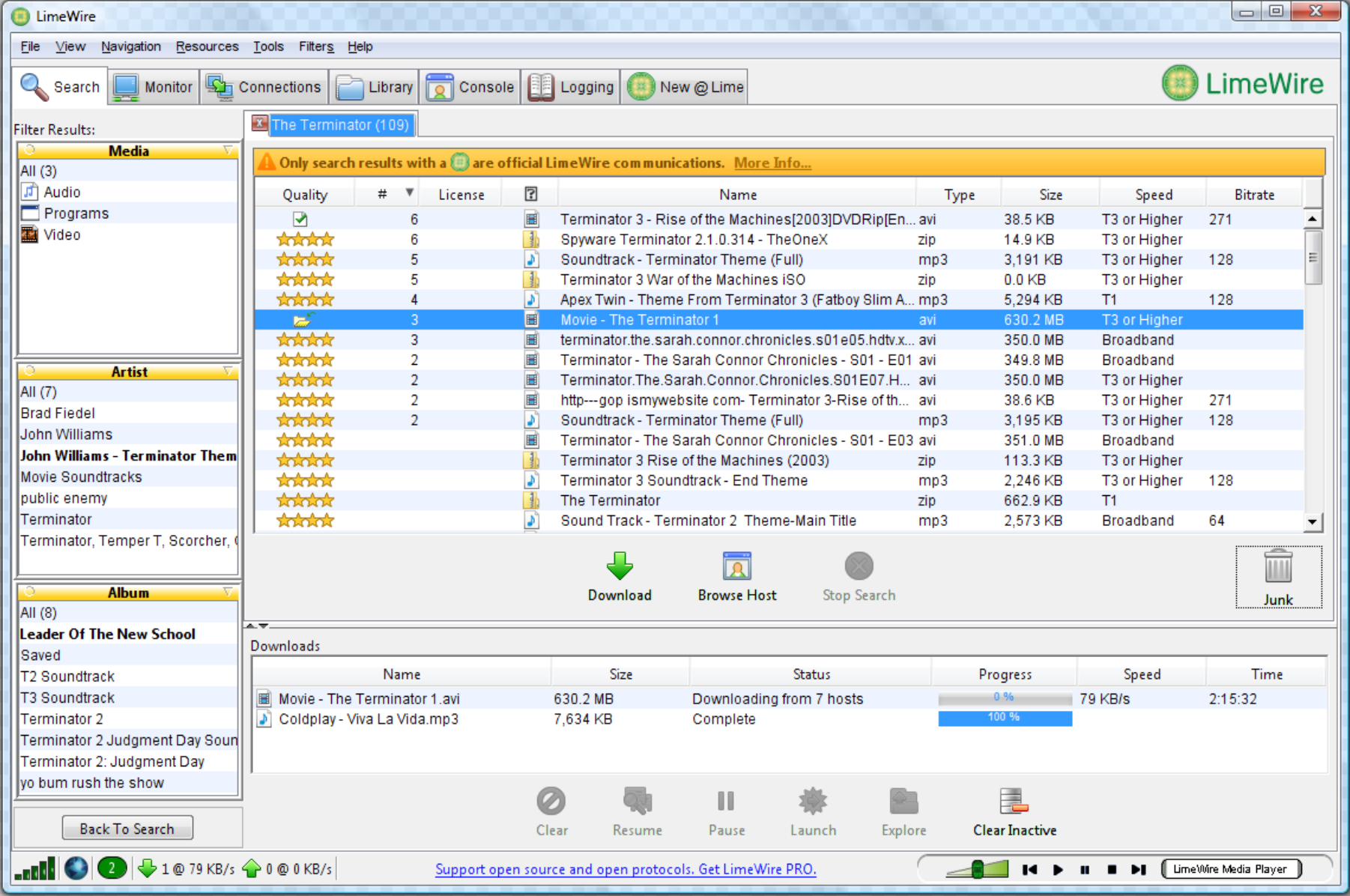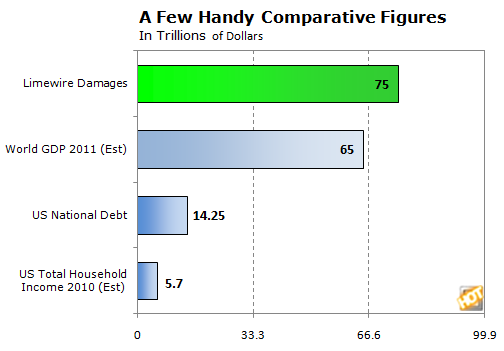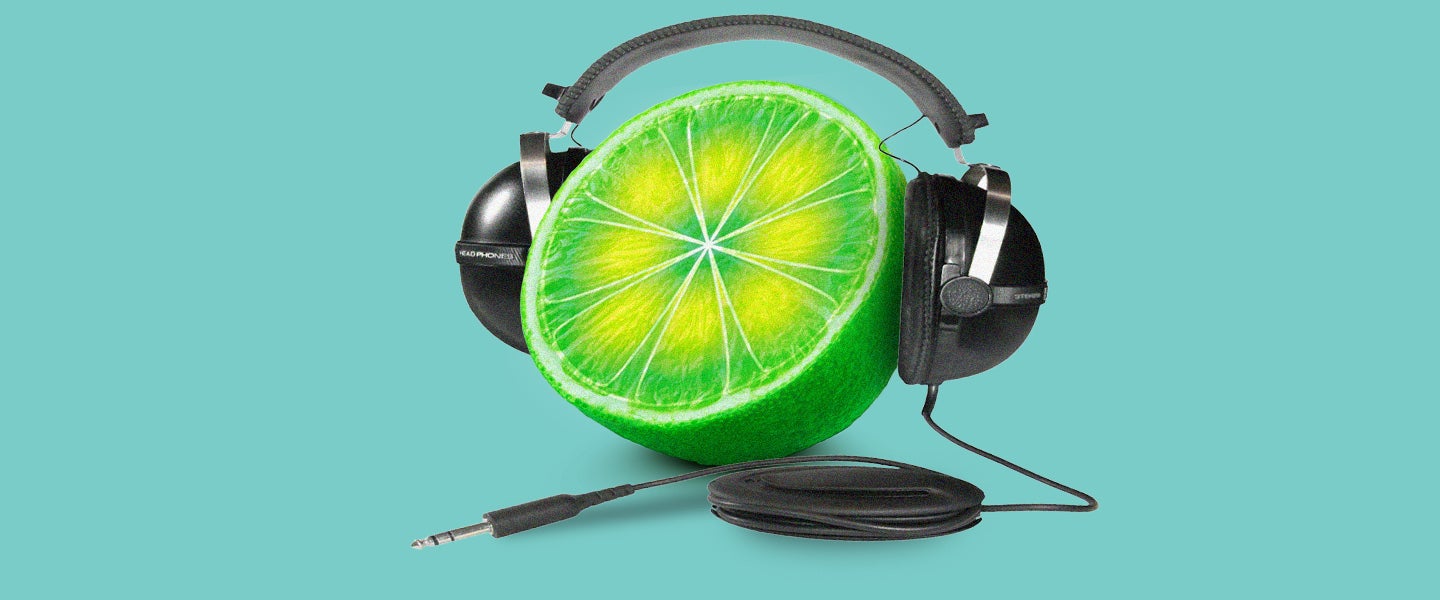In 2001, the internet’s premier file-sharing service Napster was shut down after just two years, leaving a giant vacuum in the ever-expanding peer-to-peer file-sharing space. There was, however, no putting the toothpaste back into the tube. Suddenly, it was possible — and extremely popular — to download media for free. It was only a matter of time before the next platform emerged to meet that demand.
Enter Mark Gorton, a successful hedge-fund manager who saw an opportunity for commerce in peer-to-peer networking. As such, he launched Lime Group LLC in 2000. Within Lime Group was LimeWire, a proprietary team of engineers exploring the peer-to-peer space. LimeWire was by no means an overnight success. But with a team of dedicated engineers, the software slowly grew into a file-sharing behemoth.
A Happy Accident
Greg Bildson, LimeWire COO, in “LimeWire: Beginnings”: LimeWire started at a row of desks right in front of me in the spring of 2000. But at first I didn’t notice. I was busy dealing with the twilight days in the brief life of Lime Objects [a subsidiary eventually merged into LimeWire], where I stocked a pipeline of developer hires, one of whom was an intern who was experimenting with [peer-to-peer] network Gnutella, which would prove to be the model of the future.

We didn’t get our LimeWire name until the fall of 2000. We liked “LimeNode” a lot, but that seemed a little too repetitive. Our expanded plan was to build a corporate server that would participate in the Gnutella network on behalf of companies that wished to take part.
Matt Castro, narrator of “Do You Remember LimeWire?” on YouTube: Mark Gorton released a program that would pick up the mantle of Napster [and] push the envelope of online pirating even further. The big difference between the two giants was that LimeWire had everything. Not just music. We’re talking movies, video, software, games, you name it. LimeWire had it, [and] it was all centralized into one singular program.
Bildson: Having tested and improved things for months, we were finally allowed to release a LimeWire beta to the public in November. To say we had a slow start was an understatement. At the time, we celebrated every 100 downloads and then every thousand, but that was just a drop in the bucket. We were still only a tiny fraction of the network, [and] if anything, we were too conservative in our early days. But it gave us time to better understand the space and our competitors. It would take four years at least for this to really pay off.
Aubrey Bowser, UI Developer, LimeWire: I was the product marketing face for it. Did everything except code in Java. I produced the website, open source community website, content, graphics. LimeWire in the early days was like Pied Piper [the fictional app on Silicon Valley] in their early days. It was the quintessential startup. We were a bunch of post-college grads in the center of the .mp3 revolution. These engineers led the way for Spotify.
The team wasn’t looking to replace Napster. Rather, they were really just into making P2P work. It was so new then. They open-sourced it, and a community thrived behind making the protocol work, so the .mp3 swap thing was incidental to the network capabilities.
Miracle Jones, producer of the forthcoming book series Remember the Internet: I’d known of Napster, but it was too slow and I never felt the need to download music onto my computer. Then I went to college. An engineer outfitted us with a blue ethernet cable and showed us how to log on to the local network. It was my first experience with a fast internet connection.
Miles Klee, “Why Millenials Miss LimeWire Enough to Resurrect It as a Meme,” MEL: The essence of LimeWire was this: By using it, you were breaking the law, and in trying to find any given song or video, you might accidentally download porn or malware, putting the computer itself at risk. It was as reckless as unprotected sex.
Jones: We were gobsmacked by the fast internet connection and basically couldn’t believe that we now had access to all this music and media. Eventually, we became utterly unrepentant in our wholesale pillaging of everything we could possibly steal.
Klee: At the height of LimeWire, Facebook and YouTube were brand new, and they hadn’t yet monopolized how we interact. Web 2.0 sought to turn your real-life friends into followable accounts and avatars, whereas LimeWire capitalized on near-random, anonymous connections between strangers. You couldn’t talk to whoever was hosting the file you wanted; you had to live by your wits and decide whom to trust. Primitive as that sounds, it made for a thrilling suspense you’ll never find in the walled gardens of today’s social media.
Bildson: In those early days, if you got to the point of actually downloading a file, 90 percent of download attempts would fail. This was a classic supply-and-demand problem. Supply was limited, and demand was large. But supply should increase as new people downloaded a copy of a file, right? That was only true if the downloader was using a true Gnutella client.
Jones: Everyone was downloading stuff all day long. We would grab as much as we could, then run off to class, checking in between classes to organize the lucre and start new downloads, inefficiently and redundantly replicating bad music collections everywhere on a thousand semen-crusted iMacs and Gateway 2000s.
Castro: [Soon] over 50 million users were downloading their favorite albums on a daily basis, ripping them onto a CD or transferring them over to their newly received iPod, [which] could hold up to 40,000 songs. And you weren’t about to buy 40,000 tracks of music. In 2005, LimeWire had as many users as iTunes did: 1.7 million. All of them illegally downloading music, which resulted in the music industry losing billions of dollars.


Changing the Internet
Where Napster had only lasted two years, LimeWire was on its way to surviving 10. Even as other file-sharing platforms were sued into oblivion, Gorton was able to outrun the courts. He made a point to form relationships with music industry executives, and did his best to address any legally questionable areas in the software. According to the New York Times, Gorton truly believed he was following the law the entire time.
At its peak, LimeWire was responsible for 80 percent of all illegally downloaded music in the U.S. Millennials had their first taste of infinite on-demand entertainment, and they were hooked. Meanwhile, as more users piled in, so too did bad actors.
Jones: We were coming from a decade where the record companies had been systematically screwing every single human on CDs, refusing to sell singles anymore. It was thrilling and very satisfying to be able to steal entire catalogues of an artist’s work in the “album” form that we were told was so fucking important. It allowed record companies to charge us all a buttload for the one song that was good, which is why an entire generation knows way more Bush songs than they should, which is one half of one song.
Klee: Without the discoverability of browsing or algorithms, you had to know what you wanted and fully commit to the hunt. LimeWire rewarded focus and patience instead of promoting distraction.
Castro: Movies were more of a hassle. You’d have to wait about a day or two for the download to be finished, and you didn’t even know if it was the correct file or not. The only thing you had to go by were the titles of the tracks, and people could bait you into downloading some fucked-up shit.
Jones: You were also beholden to “whatever people had elected to digitize and label” from their own collections, meaning there was a lot of KMFDM, Nine Inch Nails, a ton of Grateful Dead bootlegs and obscure prog rock.
Castro: You could look at someone’s iPod, and if a song said something like “2000_Kanye_my_chemical_romance.mp3,” you knew that they were using LimeWire.

Jones: One infamous mislabeled file was an advertisement for a club that started with Bill Clinton saying:
“My fellow Americans, I would once again like to say that I did not have sexual relations with that woman. I did, however, go to ifreeclub.com where they offer hundreds of free products. Computers, notebooks and accessories. Televisions, home importable audio and video, fashion and cosmetics, housewares and more. Visit them today at www.ifreeclub.com and do like I did. Just get it free!”
Castro: [The Bill Clinton] sample was the original rickroll. It taught us to keep vigilant and make sure that the file size of what we were downloading was correct. When we saw something that was too good to be true, it probably wasn’t.
Castro: There was also a lot of porn, like, a lot. And of course, with porn, comes some fucked-up shit. People would fuck things up by naming it something like “Paris Hilton sex tape.” But when you opened it up, bada bing, bada boom, you were now in possession of child pornography. One study by the U.S. General Accounting Office found, “1,286 titles and file names using 12 keywords known to be associated with child pornography on the Internet. 543 (about 42 percent) of those titles were associated with child pornography images.”

Castro: It was even reported that out of 123 randomly downloaded files on LimeWire, 37 of them contained malware. If you were downloading content from the program, chances are you probably had a handful of viruses on your computer. But you didn’t care. Nobody cared. It was a small price to pay for the infinite amount of music at your disposal.
Johnny Tan, systems administrator and operations manager at LimeWire, 2007–2011: The main moderation we did was over DMCA takedowns or child porn. Everything else we were largely laissez-faire about. We weren’t too fixated on fixing the mislabels and viruses. In our view, it was actually a compelling argument for our new music service. For example, let’s say you search for “Poker Face.” You’d get dozens, if not hundreds, of hits, but we’d position our legit, purchase-based ones at the top.

And the price would be reasonable, such that you’d be forced to ask yourself EVERY SINGLE TIME: “Do I pay this minimal amount to purchase a high-bit-rate, guaranteed version of ‘Poker Face’ that has all the correct metadata to properly fill out my library? Or do I take a chance with ‘PoKerr Fase by Lady Gagga – SUPER QUALITY’ that’s a few kilobytes in size?”
Sometimes you take a chance and hope for no viruses. But there are times when you’re just like, “The per-unit cost is 69 cents, F it, I’ll just buy it this time.” And “this time” happens more and more over time.
Klee: Apart from the viruses and smut, there were always rumors that users would one day be dragged into court over this unrepentant piracy.
Jones: Yeah, we had a vague sense that our galactic-scale larceny was probably some kind of violation of a university honor code or regulation or law, but no one had actually explicitly said anything about not doing it. There were just thick blue ethernet cables for everyone and a big shrug from all authority figures, like some kind of Oklahoma land-run. It was glorious.
Joel Tenenbaum, sued by the RIAA for $4.5 million for downloading 30 songs: The final verdict was $675,000. I filed for bankruptcy years ago; the RIAA never got a dime from me, while I — hopefully — cost them millions of dollars to litigate me. Professor Nesson [Tenenbaum’s defense lawyer] was very vocal in the fact that I was being made an example of, and argued that this was an illegal use of the statute. It felt very unfair, but I have the satisfaction of knowing they were more hurt by the lawsuit than I was.
Castro: The music industry was pissed, and someone needed to hang for it. Profit for albums kept plummeting, with the only program helping them being the iTunes shop, which was released three years after the birth of LimeWire. File-sharing changed the entire music industry as a whole, and nobody knew what the fuck to do. So companies did what companies do at a time of crisis. They sued.
Tan: Ultimately, it boils down to this: The media industry (both back then as well as to this day) doesn’t give people the freedom and flexibility that we desire. We don’t want to pay $150 for a bundle of mostly worthless stuff like cable, nor do we want to be nickel-and-dimed for every possible subscription that has even a mild interest for us, which is what we get today.
LimeWire allowed us to get around a lot of those limitations and made distribution particularly straightforward. That trained the legal eyes of the media dinosaurs on us, leading to our ultimate demise.
Turning LimeWires Into Grapevines
In 2006, LimeWire reportedly had 4 million active users a day, and was well on its way to being downloaded 200 million times. The company itself was extremely profitable, thanks to the small percentage of users who opted for the paid service. According to the New York Times, LimeWire’s revenue in 2006 was $20 million.
The company’s pockets were deep and its user base was vast, but with a tsunami of litigation and bad press (from all the viruses and child porn) bearing down, it needed to open legacy music industry executives’ eyes to their inevitable future: a subscription-based streaming model.
In 2007, Gorton hired his first CEO, George Searle; renovated a 15-story, cast-iron building in New York City; and focused LimeWire’s attention toward the horizon.
George Searle, LimeWire CEO, in a corporate blog post four months and 12 days before the company was shut down by a federal judge: As rich as our history is, I’m very excited about what the next 10 years will bring and firmly believe the best is yet to come.
Rochelle DiRe, VP of Human Resources, LimeWire: Prior to George [Searle] being hired, the overall vision of the company was to build the platform. It was just Mark [Gorton], 35 other engineers and next to no corporate structure. I called it Engineering Eden — it was well-funded, and led by a former engineer. At that point, there was a low, single-digit percentage of their users converting to paid users, but most of the users were free, so it was a very simple model to administer.
Bowser: We were making money through ads and the higher support tier from LimeWire Pro.
DiRe: But the strategy pivoted to making friends with the music labels, so we needed to staff up with lawyers [and] marketing people.

Tan: By 2010, we were largely finished with Grapevine [the Spotify-esque subscription service]. It was up and running, but the content was mostly indie with a few very small labels on there. Still, it was in many ways a precursor to things like Spotify, with one distinguishing feature: for a monthly subscription fee, instead of streaming whatever you wanted, you were going to be allowed to download and keep, or “own,” a certain amount of songs every month, depending on your plan.


DiRe: We were basically building what would turn into a Spotify. From what I understand, within the music industry, there was a battle between the younger, digital side who saw the future of their industry, and the legal teams who just saw the pain of the past.
Tan: The fact that users would “own” songs was the deal-breaker for a lot of the dinosaur record labels. I remember one meeting with a music label I won’t name, where the exec in the room basically told us, “If you listen to a Madonna song, I want you to pay us for that privilege. You never own music, you simply buy a license to consume that music at that moment. Next year, when you want to listen to that same song, I want you to pay us again. Thirty years from now, when your grandchildren want to listen to that Madonna song, I want them to pay us. You will never own this music, you only buy a temporary right to listen to that music at that moment, nothing more.”
Jarret Battisti, Global Production Manager, Lime Company: I would have loved to see Grapevine released to the public. We were developing it just ahead of Spotify getting its U.S. licensing, and I think the service had an honest shot.
DiRe: But they were out for blood, and ended up turning down what I think would’ve been a very profitable business model for them, just to take revenge on the early pioneers. So that was sad. It was a little bit like [trombone noises].
Searle, two months and 10 days before being shut down by a federal judge: We now have more employees, more resources and more users than ever before. We’re proud to say that LimeWire has become the world’s most popular P2P file-sharing program. I firmly believe the best is yet to come!
The End of the Grapevine
Music industry executives couldn’t be convinced. The Recording Industry Association of America came at LimeWire with a $75 trillion claim in damages. After lengthy litigation, LimeWire ultimately settled out of court for $105 million to 13 different record labels.

DiRe: The possibility of being extinguished was right there, and the possibility of doing something huge, pioneering and groundbreaking was right there too. But we were outgunned. The record labels were so spiteful, they not only wanted us closed, they demanded that we destroy the code. Things started to cut against us, and we had to do layoffs.
Battisti: It was sort of a given that the LimeWire talks with the labels and RIAA could come to an impasse at any point, but we had a decent amount of confidence that things would settle and we could continue to operate. Of course, when talk of the injunction began, we couldn’t help but feel uneasy.
Tan: It was a truly sad moment when we had to lay off about one-third of the company [because of the lawsuits]. This occurred about six to eight months before we ultimately shut down. Lots of tears and feelings of betrayal on that day. Before that, it was a tight-knit team. Everyone believed in what was possible, and no one left.
DiRe: We fought to the very end. [Judge Kimba Wood’s ruling] was the moment of truth, and it was heartbreaking. We felt she wasn’t an informed judge, not very technologically savvy. Maybe in a different judge’s hands it would’ve turned out differently. But then we closed, and that was that. Everyone went their separate ways.
Battisti: Shelving Grapevine was really the one that hurt the most. It felt like the team had something special in the works there.

Tenenbaum: The whole thing seems adorably dated now: downloading Limp Bizkit and Green Day and being sued for that, when all the labels seemed to have switched over to a radio-like model where you get free music with ads, or a subscription service like Spotify. Or that you can legally watch all the songs I was sued for on YouTube, where they’ve all been posted in duplicates.
But I’m not any kind of expert on the music business. I’m a public-school teacher now. I Spotify a bit, but mostly Pandora, or use the actual files I have.
Battisti: I was with LimeWire nearly until the day the doors were locked forever. It was a bit of a whirlwind, to say the least, the whole thing felt like something out of a film. But after the injunction was official and we shut down the P2P client, my manager asked if I wanted to stay on to help with customer responses. I agreed and began sending form emails to virtually anyone who contacted us. There were about four of us, including the lead of the customer support group. The rest of the office was basically a ghost town, but we sat there, just emailing away. Reactions ranged from anger to empathy. It was an emotional experience, and certainly unique in my professional history.
Klee: Nothing lasts, and nowhere is that as true as on the bleeding edge of technology. For all its flaws, and despite its basically indefensible premise, LimeWire offered a chance to outrun the powers that be, toward a future that wouldn’t arrive. LimeWire itself was a glitch, and a happy one, too.
DiRe: This shoulda-coulda is very real. Things could have and should have turned out differently. We had 50-something million subscribers.
Battisti: It’s tough to tell where a now-legacy tech brand like LimeWire would sit in today’s landscape. Adapting and staying relevant is no small feat.
DiRe: But if you squint, and think about if it would’ve worked, we were a decade ahead of our time, in so many ways.
Bowser: [It] was a great time with talented people still dear to my heart. I miss all of them.
DiRe: We had this amazing culture, amazing office, at an amazing time in the digital revolution. LimeWire should’ve been right there with, or instead of, Spotify. It didn’t work out that way, of course, but we had fun trying!

